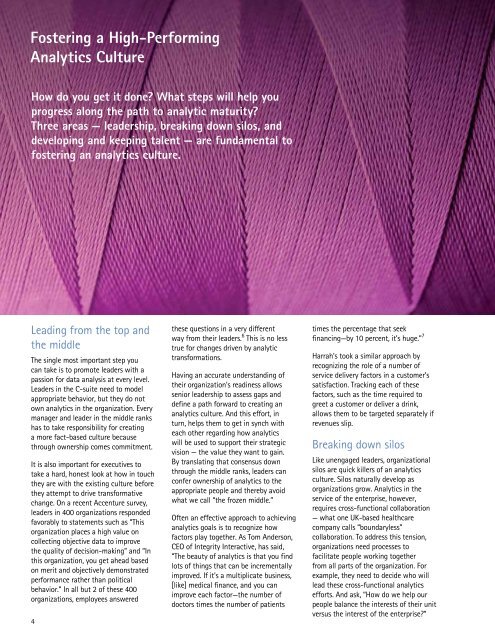Analytics Culture: The Secret to Success
Analytics Culture: The Secret to Success
Analytics Culture: The Secret to Success
You also want an ePaper? Increase the reach of your titles
YUMPU automatically turns print PDFs into web optimized ePapers that Google loves.
Fostering a High-Performing<br />
<strong>Analytics</strong> <strong>Culture</strong><br />
How do you get it done? What steps will help you<br />
progress along the path <strong>to</strong> analytic maturity?<br />
Three areas — leadership, breaking down silos, and<br />
developing and keeping talent — are fundamental <strong>to</strong><br />
fostering an analytics culture.<br />
Leading from the <strong>to</strong>p and<br />
the middle<br />
<strong>The</strong> single most important step you<br />
can take is <strong>to</strong> promote leaders with a<br />
passion for data analysis at every level.<br />
Leaders in the C-suite need <strong>to</strong> model<br />
appropriate behavior, but they do not<br />
own analytics in the organization. Every<br />
manager and leader in the middle ranks<br />
has <strong>to</strong> take responsibility for creating<br />
a more fact-based culture because<br />
through ownership comes commitment.<br />
It is also important for executives <strong>to</strong><br />
take a hard, honest look at how in <strong>to</strong>uch<br />
they are with the existing culture before<br />
they attempt <strong>to</strong> drive transformative<br />
change. On a recent Accenture survey,<br />
leaders in 400 organizations responded<br />
favorably <strong>to</strong> statements such as “This<br />
organization places a high value on<br />
collecting objective data <strong>to</strong> improve<br />
the quality of decision-making” and “In<br />
this organization, you get ahead based<br />
on merit and objectively demonstrated<br />
performance rather than political<br />
behavior.” In all but 2 of these 400<br />
organizations, employees answered<br />
4<br />
these questions in a very different<br />
way from their leaders. 6 This is no less<br />
true for changes driven by analytic<br />
transformations.<br />
Having an accurate understanding of<br />
their organization’s readiness allows<br />
senior leadership <strong>to</strong> assess gaps and<br />
define a path forward <strong>to</strong> creating an<br />
analytics culture. And this effort, in<br />
turn, helps them <strong>to</strong> get in synch with<br />
each other regarding how analytics<br />
will be used <strong>to</strong> support their strategic<br />
vision — the value they want <strong>to</strong> gain.<br />
By translating that consensus down<br />
through the middle ranks, leaders can<br />
confer ownership of analytics <strong>to</strong> the<br />
appropriate people and thereby avoid<br />
what we call “the frozen middle.”<br />
Often an effective approach <strong>to</strong> achieving<br />
analytics goals is <strong>to</strong> recognize how<br />
fac<strong>to</strong>rs play <strong>to</strong>gether. As Tom Anderson,<br />
CEO of Integrity Interactive, has said,<br />
“<strong>The</strong> beauty of analytics is that you find<br />
lots of things that can be incrementally<br />
improved. If it’s a multiplicate business,<br />
[like] medical finance, and you can<br />
improve each fac<strong>to</strong>r—the number of<br />
doc<strong>to</strong>rs times the number of patients<br />
times the percentage that seek<br />
financing—by 10 percent, it’s huge.” 7<br />
Harrah’s <strong>to</strong>ok a similar approach by<br />
recognizing the role of a number of<br />
service delivery fac<strong>to</strong>rs in a cus<strong>to</strong>mer’s<br />
satisfaction. Tracking each of these<br />
fac<strong>to</strong>rs, such as the time required <strong>to</strong><br />
greet a cus<strong>to</strong>mer or deliver a drink,<br />
allows them <strong>to</strong> be targeted separately if<br />
revenues slip.<br />
Breaking down silos<br />
Like unengaged leaders, organizational<br />
silos are quick killers of an analytics<br />
culture. Silos naturally develop as<br />
organizations grow. <strong>Analytics</strong> in the<br />
service of the enterprise, however,<br />
requires cross-functional collaboration<br />
— what one UK-based healthcare<br />
company calls “boundaryless”<br />
collaboration. To address this tension,<br />
organizations need processes <strong>to</strong><br />
facilitate people working <strong>to</strong>gether<br />
from all parts of the organization. For<br />
example, they need <strong>to</strong> decide who will<br />
lead these cross-functional analytics<br />
efforts. And ask, “How do we help our<br />
people balance the interests of their unit<br />
versus the interest of the enterprise?”

















